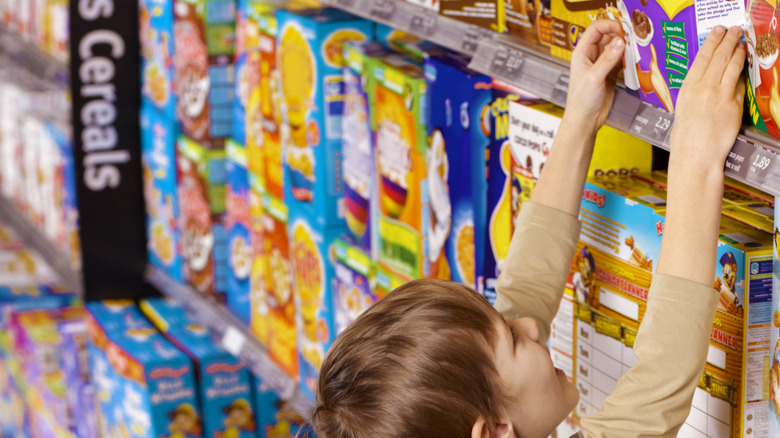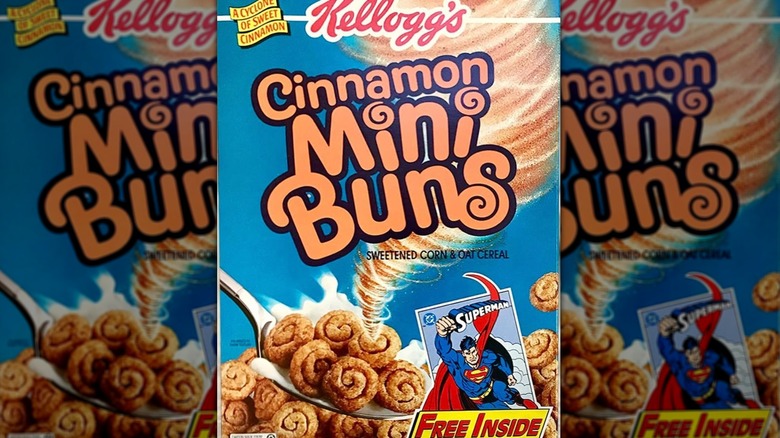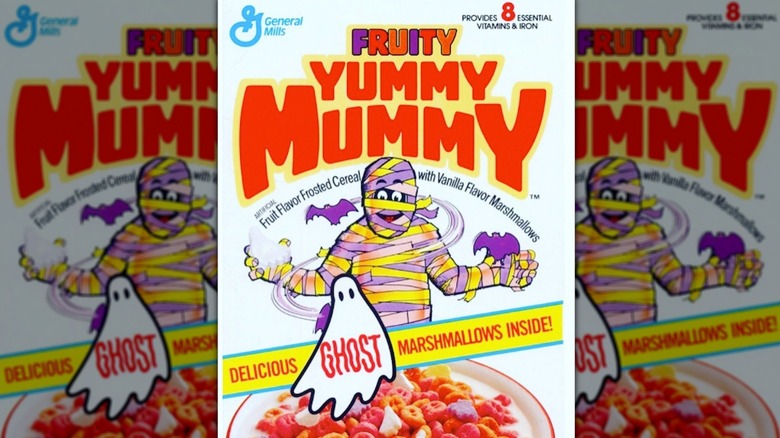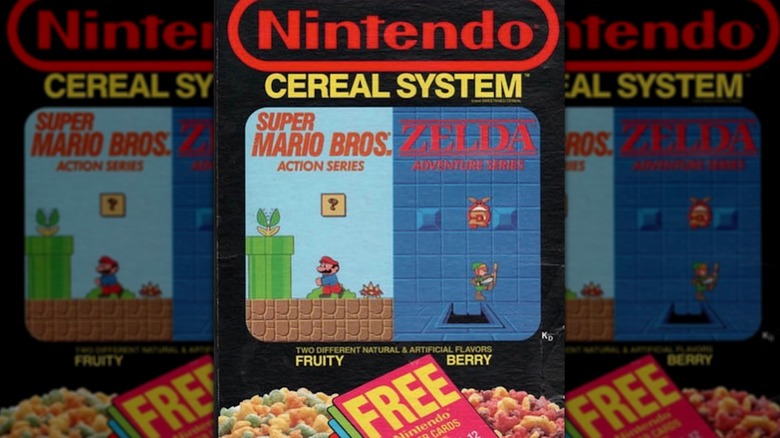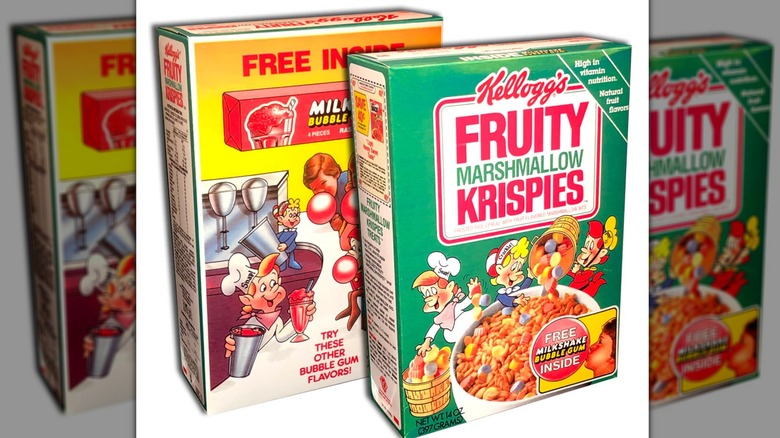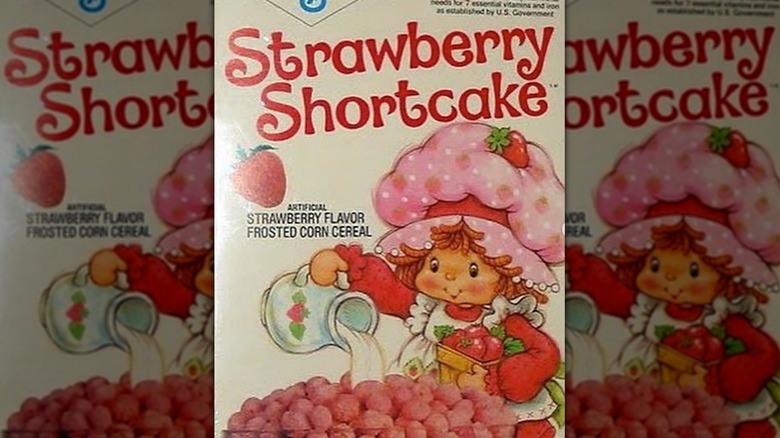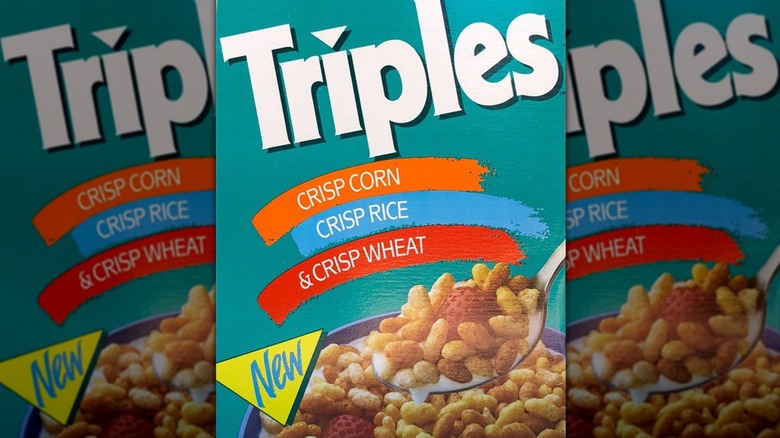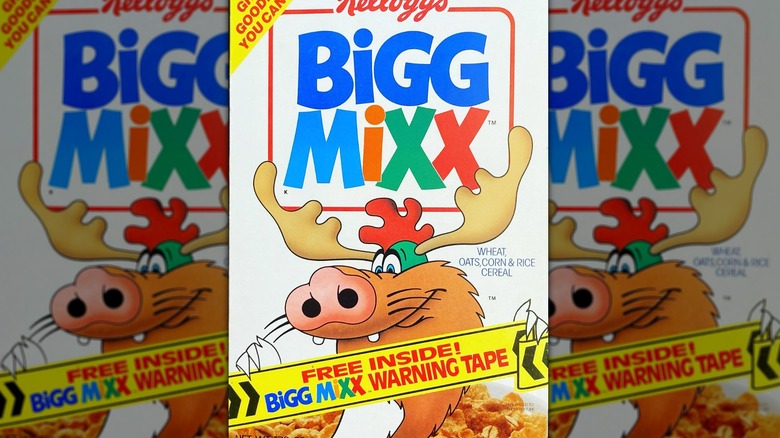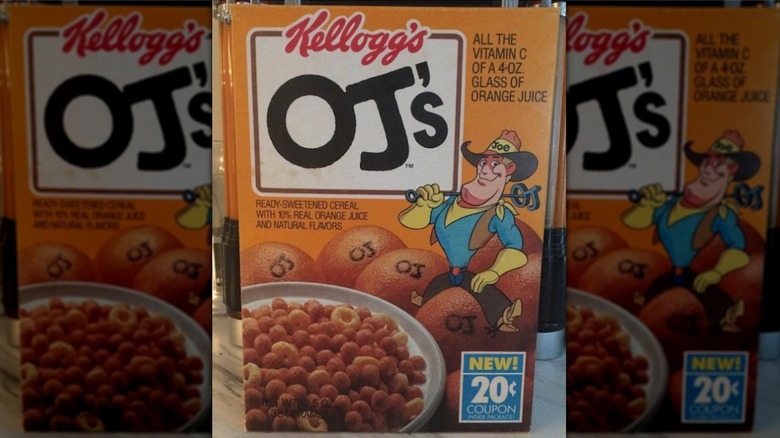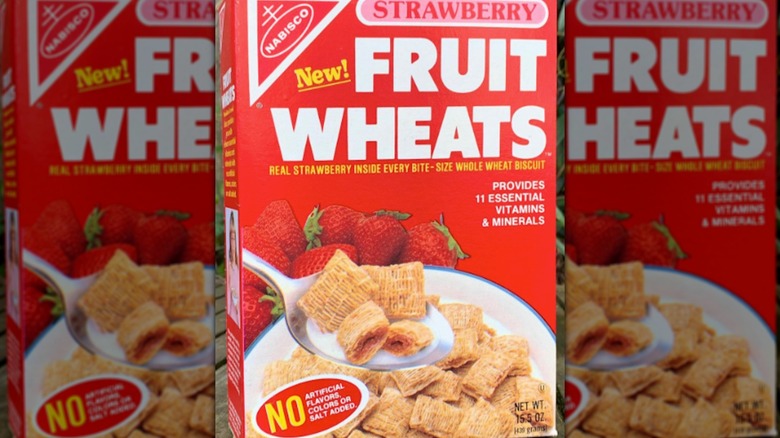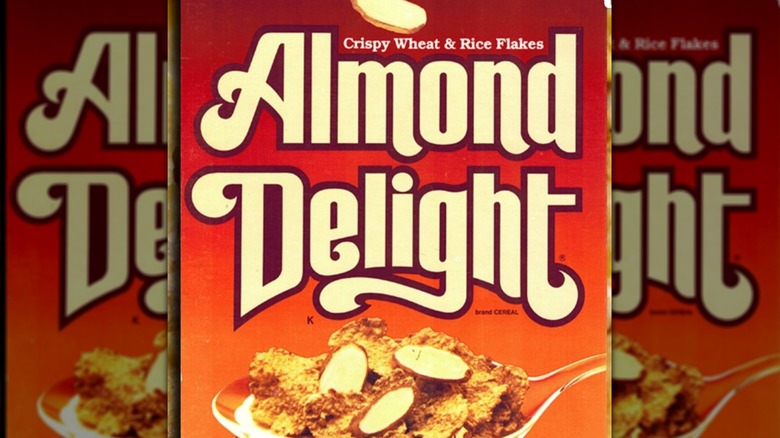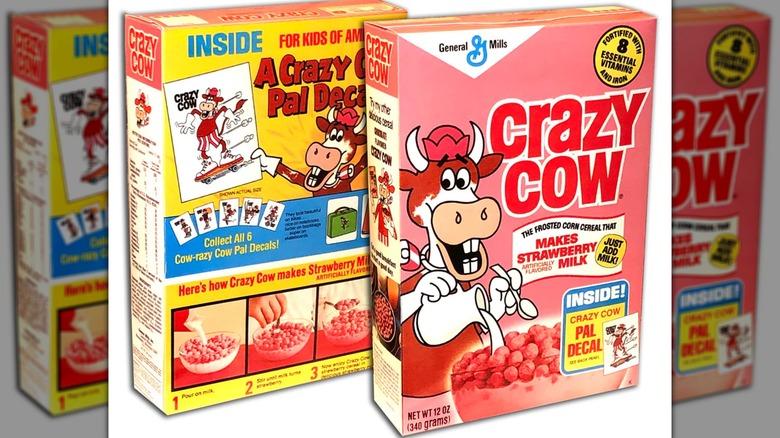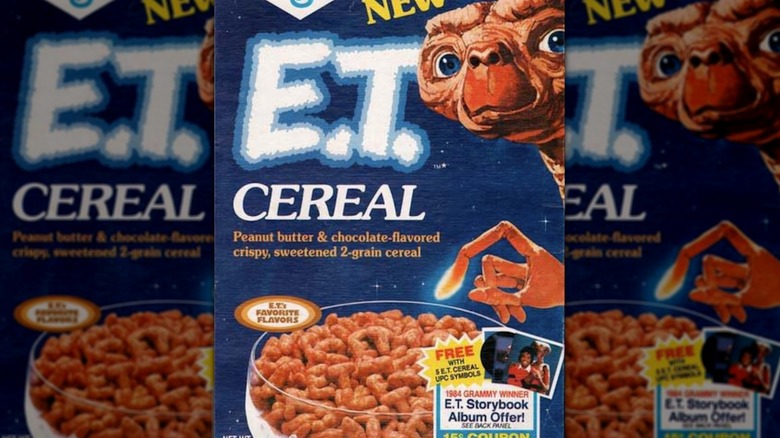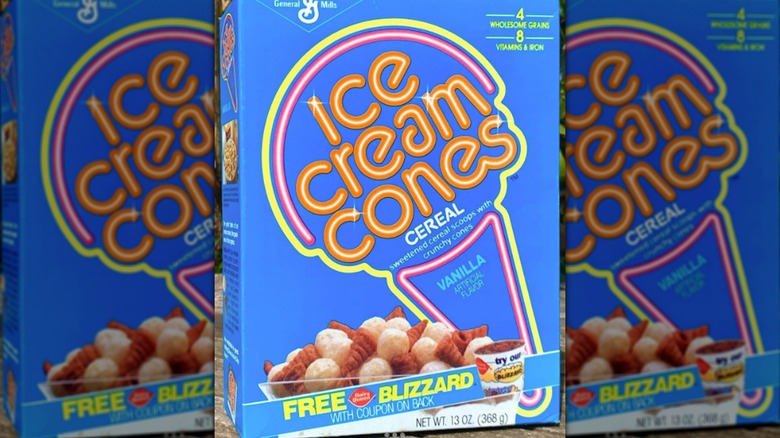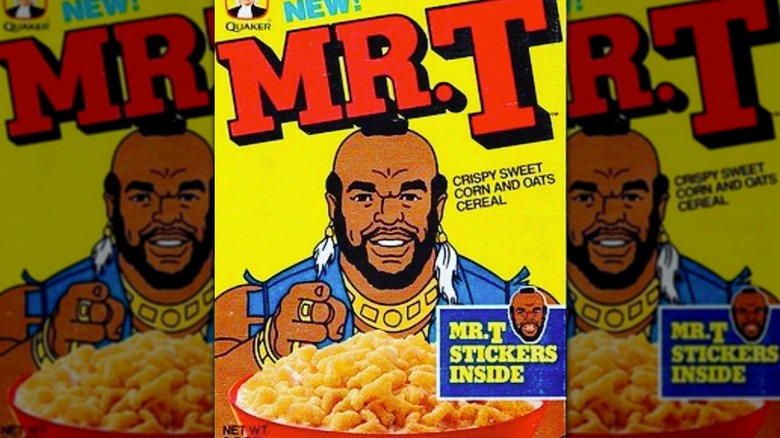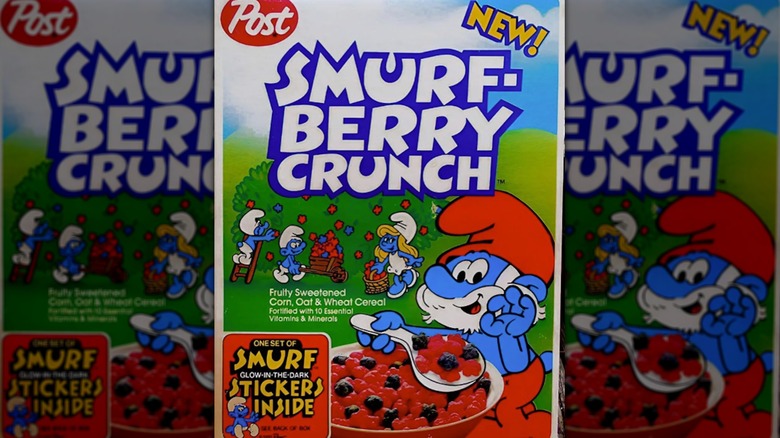Discontinued Cereals We'll Probably Never Get To Eat Again
Breakfast is funny — perhaps because of the tightness of time during morning workday and school-day preparations, many people don't mind, or even prefer, eating the same thing first thing, every day. Cereal makes for an especially reliable and consistent breakfast. It's quick, it's inexpensive, and it's easy to pour out a bowl's worth of whatever, top it off with milk, shovel it in, and head out the door. Some of the most famous brands in all of food are cereal makers and their products: such as Kellogg's — maker of Rice Krispies and the historical Corn Flakes — and General Mills, with Cheerios and Cinnamon Toast Crunch.
Certain cereals are so ingrained that it's hard for new ones to make any inroads into hearts, minds, and markets. Or, tastes change, and once popular cereals just don't thrill the masses anymore. Cereals can even be time capsules of how people ate breakfast in a certain era, and for a variety of reasons economic, social, and cultural, some just don't exist anymore. We won't and can't let cereal die, and so here are some long disappeared but still fondly remembered cereals that we'll probably never eat again.
Cinnamon Mini Buns
Cinnamon Toast Crunch isn't the worst cereal for you despite its ultra-sweet profile, but it was such a success for General Mills that other big cereal companies tried to hone in on what looked like a big market for cinnamon-sugar-flavored cereal. In 1991, Kellogg's released Cinnamon Mini Buns, marketing the cereal as a low-fat, miniature version of hot breakfast favorite cinnamon rolls the way that General Mills likened Cinnamon Toast Crunch to cinnamon toast. Small round nuggets, Cinnamon Mini Buns were made out of a whole grain oats and corn blend and a splash of cinnamon.
Kellogg's never did dethrone Cinnamon Toast Crunch's market dominance, but Cinnamon Mini Buns sold well enough that they stayed in production until 2005. At that point, the producer tried to reboot the product, changing the recipe slightly and renaming it Mini Swirlz Cinnamon Buns. That incarnation didn't last, and it was out of stores by 2009.
Fruit Brute and Yummy Mummy
Hideous monsters and sugary breakfast cereals made for children don't seem like the most obvious combination, but it's all worked out well for General Mills. In 1971, the company debuted its first marshmallow-laced and sweet-glazed Monster Cereals, with Count Chocula and Franken Berry, each with its own mascot — a chocolate-loving vampire and a pink spin on Dr. Frankenstein's creation, respectively. Ghostly, blueberry-based Boo Berry came along in 1972, followed in 1974 by Fruit Brute. Represented by a cartoon werewolf, the cereal pieces and its marshmallows were brightly colored and flavored with a blend of artificial fruits. Never as iconic or popular as the other Monster Cereals, Fruit Brute disappeared in 1982.
In 1987, General Mills tried again, rebranding and reformulating Fruit Brute slightly as Fruity Yummy Mummy. Once again, it didn't connect with the public, and it was discontinued in 1992. General Mills briefly revived both long gone cereals for a Halloween 2013 promotion and in the 2020s included both in Monster Mash Remix, a seasonal offering that throws all of the Monster Cereals, past and present, into one box.
Nintendo Cereal System
Japanese game-maker Nintendo revived the video game industry after an Atari-led crash in the mid-1980s, and the company's Nintendo Entertainment System sold more than 60 million units, making it one of the hottest toys and consumer electronics of the late '80s. Lots of American kids were wild about Nintendo in 1989, and Ralston understood the fervor when it created the Nintendo Cereal System that year. Playing off of the name of the game console, the cereal alluded to the NES's interchangeable cartridges, as boxes contained two cereals, each based on one of Nintendo's best-known properties, "Super Mario Bros" and "The Legend of Zelda." As the super-catchy, video game-music based ad jingle explained, the Mario cereal included edible representations of power-up mushrooms, villainous Goombas and Koopas, and the titular heroic plumber; the Zelda cereal used imagery from that game, including shields, hearts, keys, and crusading warrior main character Link.
Ralston turned off production on the Nintendo Cereal System in 1991, the same year that fervor in the NES died down considerably. The reason: The launch of the next-generation Super Nintendo Entertainment System.
Marshmallow Rice Krispies
By 1982, Kellogg's had figured out that a significant number of people buy its Rice Krispies cereal, one of the first selections in our fantasy food draft for breakfast cereals: to combine it with melted marshmallows to make Rice Krispies treats. The company both cut out the middle-man and made the dessert into breakfast with Marshmallow Rice Krispies Cereal. Essentially Rice Krispies treats deconstructed, a box included the familiar rice cereal along with plenty of miniature, semi-solid marshmallows also known as "marbits." In 1987, Kellogg's revamped the product and made it into an even more sugary and flavorful cereal, unveiling Fruity Marshmallow Krispies, mixing frosted Rice Krispies with marbits in orange, lemon, raspberry, and grape flavors.
Five years later, Kellogg's reformulated that permutation to make the colored marshmallows resemble the inspirational fruits, spending $11.4 million on the endeavor. The cereal's texture and taste suffered as a result, and marshmallow-bolstered Rice Krispies disappeared around the same time that Rice Krispies Treats cereal appeared. More or less Rice Krispies treats, with cereal and marshmallow paste, made into irregular, bite-size clumps, that cereal stayed around the marketplace until 2021.
Strawberry Shortcake
Initially designed in the early 1970s for use in cards and gift store merchandise by American Greetings, Strawberry Shortcake became a multimedia phenomenon by decade's end. In 1980, the childlike cherub from Strawberryland who dressed in berry-themed 1800s clothing and loved to bake, alongside her other fruit-and-treat-inspired friends, graced nearly 700 products and generated $100 million in revenue. A year later, the doll, toy, and merch craze still going strong, General Mills licensed the rights to use Strawberry Shortcake, Orange Blossom, and Blueberry Muffin for a line of cereals. Each cereal was made from sweetened corn puffs and had a unique, artificial flavor to correspond to young consumers' preferred character: strawberry, orange, and blueberry, respectively. The flagship cereal, was, according to box copy, "berry delicious," (via Mr. Breakfast).
As fads naturally do, everything Strawberry Shortcake slowly fell out of favor in the mid-1980s, and General Mills quietly retired the cereals by 1985. None of the flavors have ever made a comeback, despite American Greetings rebooting and reviving the Strawberry Shortcake merchandise line on multiple occasions.
Triples
In 1991, General Mills made it very clear which beloved, best-selling cereal giant it hoped to topple with its latest breakfast product, Triples: "Better tasting than Kellogg's Rice Krispies" banners across boxes emphatically stated, (via "The Great American Cereal Book"). Ads for the item described and simultaneously promised that Triples was "a crunchy cereal that tastes so good you'll do a triple take!" Other commercials flat out stated, (via Mr. Breakfast), "If you like Rice Krispies, try Triples." Indeed, Triples was made from three different grains, all puffed out the way Kellogg's did with Rice Krispies, except General Mills did it with morsels of barely-sweetened corn, wheat, and rice. With a triple play of visibly distinctively different pieces, Triples offered multiple slightly varying tastes and textures.
Rice Krispies was too firmly entrenched in the cereal world to be unseated by a puffed-up competitor. General Mills produced the cereal for six years, quietly discontinuing Triples in 1997.
Bigg Mixx
It seems that if a cereal wanted to survive in the 1980s, it needed to have a persuasive cartoon mascot to appeal to kids by appearing in TV commercials and boxes of the product. In 1989, Kellogg's launched a brand new cereal with an adult-styled formulation but marketed to children with a ready-made mascot out of the gate. Kellogg's Bigg Mixx appeared to be a combination of a bunch of other cereals, all thrown into the same box and poured into the same bowl. The product consisted of oat pieces, large raisins, and flakes made from rice, wheat, and corn. Befitting such a haphazard big mix was Bigg Mixx, a strange and grotesque cartoon cryptid that lived in the woods like a Sasquatch and was the combination of a moose, chicken, pig, and wolf — with prominent antlers, comb, and fur.
Marketing a product to children that was more suited to healthy grown-up eaters didn't play out for Kellogg's. The innovative cereal with the bizarre mascot was discontinued in 1991.
OJ's
Cereal makers commonly and historically use fruit flavoring, or the addition of actual dried fruit, to make their product of flakes and grains seem more exciting, taste a little better, and add a hint of nutrition. But the fruits used are almost always raisins, apples, or berries, which means Kellogg's faced an uphill battle in 1985 when it wanted large swaths of its customer base to try one of the few citrus-flavored cereals ever attempted to that point.
Kellogg's really wanted consumers to know that OJ's was an orange or orange juice-flavored cereal. Beyond the name, the pieces of sweetened and puffed corn were shaped like the letter "O" and came in an orange-colored box decorated with pictures of cowboy mascot Joe the OJ's Orange Rancher (and his trusty horse-like riding orange) and a promise that the cereal was produced with so much real orange juice that it packed as much vitamin C as could be found in half a glass of orange juice.
Some people think milk doesn't belong anywhere near cereal, and when it was added to OJ's, it produced the effect of a crunchy Orange Julius. However polarizing that may be, the cereal was discontinued after only about a year on the market.
Fruit Wheats
With a nod to the glitzy, status-obsessed world of the 1980s into which Fruit Wheats entered upon its launch in 1986, T.V. commercials proclaimed the Nabisco product to be "The 'In' Cereal." Not only was the cereal new and interesting, but it literally looked inward. Like Frosted Mini-Wheats without the frosting, each bite-size morsel of woven wheat strand pillows was stuffed with something to make them taste not so bland: a fruit paste made mostly out of real apples, raisins, or strawberries. Nabisco's marketing for Fruit Wheats emphasized how the product saved customers the trouble of having to put fruit on their cereal because it was already hiding inside. The line initially sold well enough that in 1988, Nabisco added a new variety of Fruit Wheats: raspberry.
In 1992, Nabisco got out of the cereal business, selling its portfolio of brands to Kraft, at the time a division of Philip Morris. Many of those cereals would end up discontinued, including Fruit Wheats.
Almond Delight
General Mills, Post, and Kellogg's dominated the cereal market in the 1980s, so to make any headway, an upstart like Ralston had to get creative. In 1986, it based a new product around an innovation: flakes made from a mixture of corn and rice, making for a thin but hearty flat and toasted cereal. The flakes stayed crunchy in milk because of the wheat, but tasted light because of the rice. Then Ralston took what it had to the next level, using the multi-carb flake as the basis for a European-style muesli, but sweetened the way Americans liked. Almond Delight flakes were given a jolt with brown sugar and coconut and complemented by the generous addition of sugary oat clusters and sliced almonds. It was as sweet and interesting as kids' cereals but marketed to grown-ups, up to and including premiums.
Cereal box prizes grew up with us, and Almond Delight's were clearly's adult-targeted: real U.S. currency, including rare and interesting collectible pieces. With wide appeal and a protein punch from all those almonds, Almond Delight stayed on store shelves until 1996, when General Mills bought Ralston and eventually did away with many of its legacy brands.
Crazy Cow
Amidst the many health food phenomena of the 1970s, General Mills marketed a cereal that was proudly and abundantly loaded with sugar. Crazy Cow, making its way to store shelves throughout the 1970s, initially came in a flagship chocolate flavor, billed as "the frosted cereal that makes chocolate flavored milk." Kids could get a "Star Wars"-themed free item inside the box while sweetened chocolate flavoring seeped out of cereal and into the milk as it stood. A strawberry style of Crazy Cow was also sold, which turned flavorless milk into sugary, berry-flavored milk.
"If you've got a finicky eater on your hands, you know you can take nothing for granted," boxes said, reaching out to wary parents, according to Mr. Breakfast. Created with a cereal mascot already in place — a visibly unhinged smiling farm animal, Crazy Cow, apparently already loaded up on sugar — the cereal disappeared from supermarkets by 1980.
E.T. Cereal
Getting a cereal company to at least temporarily produce and distribute a product based on an intellectual property first became a vital part of a kid-oriented movie or T.V. show's marketing plan in the 1980s. One of the first projects with a spinoff, tie-in cereal: "E.T.: The Extra-Terrestrial," the top-grossing movie of 1982 and at one point, of all time. The film revolved around the profound friendship between a little boy and the adorable lost alien who lands in his suburban subdivision, who along the way picks up a taste for Reese's Pieces candy. When E.T. Cereal hit stores in 1984, nearly two years after the movie first played in theaters, General Mills plastered boxes with images of the iconic alien and his lit-up finger and made the cereal taste somewhat like Reese's Pieces — it was similarly chocolate and peanut butter flavored.
When "E.T." mania died off, General Mills phased out E.T. Cereal. However, it held on to the recipe. In the early 1990s, it only barely reworked the formula and released another chocolate and peanut butter cereal: Reese's Puffs, still sold in the 21st century.
Ice Cream Cones
Ralston had a hit with the introduction of Cookie Crisp in 1977, and after a decade of watching that product succeed, competitor General Mills gave kids another breakfast cereal made to look and taste like another dessert no reasonable parent would likely serve first thing in the morning: ice cream. In 1987, Ice Cream Cones hit supermarkets, comprising of two distinct elements: tiny round white puffs with brown speckles meant to imitate the taste of vanilla ice cream with chocolate chips, and crunchy triangles that strongly emulated the flavor of waffle cones. When milk was applied, a bowl of Ice Cream Cones (whether the original chocolate chip variety or the later-added vanilla version) tasted somewhat like a bowl of melted, chunky ice cream. The boxes and commercials nostalgically harkened back to the days of the Good Humor Man, with a mascot named Ice Cream Jones who proudly delivers Ice Cream Cones.
Despite literally serving kids ice cream for breakfast, neither flavor of Ice Cream Cones took off in a crowded cereal market. General Mills ended production on the cereal after just one year.
Mr. T
A massively popular cultural figure in the 1980s, former bouncer Laurence Tureaud was everywhere, bringing his gold chain and mohawk-adorned visage to the blockbuster movie "Rocky III" (as boxer Clubber Lang), the NBC action-drama "The A-Team" (as B.A. Baracus), and to kid world. Mr. T voiced Mr. T on "Mister T," a 1983 to 1985 Saturday morning cartoon, which led to the tie-in breakfast cereal, Mr. T.
First produced by Quaker in 1984, Mr. T the cereal had a similar texture and flavor to the company's Cap'n Crunch, except that the brown sugar sweetened corn-and-oats pieces came in the shape of the letter T. The product was immortalized in the 1985 comedy "Pee-Wee's Big Adventure" — Pee-Wee Herman (Paul Reubens) grabs a box while imitating Mr. T and spoofing his catchphrase: "I pity the fool who don't eat my cereal!" The cereal lasted longer than all the other parts of Mr. T mania — "The A-Team" went off the air in 1987, two years after the cartoon show did, while Quaker kept manufacturing the T-shaped stuff until 1993.
Smurf-Berry Crunch
Created in the 1950s by Belgian comic book artist Peyo, Les Schtroumpfs delighted Europeans of all ages across many media for decades. The little blue elf-like beings, all named after their most dominant character trait and living together in a utopian society in the woods, took off in the U.S. in 1981 with the launch of the NBC Saturday morning cartoon "The Smurfs." The Smurfs were quickly and abundantly merchandised to meet the delightful demand for the brand, and in 1983,Post devised a breakfast cereal geared to kids based off of the Smurfs' in-universe source of sustenance. Unlike the Smurfs' Smurfberries, Post's Smurf-Berry Crunch only suggested the presence of fruit, as they were grain puffs made from sweetened corn, oats, and wheat dyed to look like berries.
In 1988, with the Smurfs era of cultural relevance and Saturday morning dominance waning, Post replaced the original Smurfberries cereal with Smurf Magic Berries — this one had marshmallows. By the time "The Smurfs" went off the air in the early 1990s, neither Smurf cereal remained in production.
